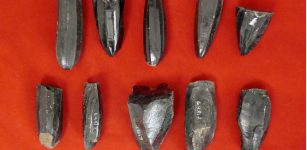Ancient Temple Dedicated To Aztec God Xipe Totec Discovered In Mexico Reveals A Gruesome Story
Conny Waters - AncientPages.com - Xipe Totec was an Aztec god worshiped by people across what is now central and western Mexico and the Gulf coast. It was a fearsome deity who according to the Aztecs invented war.
He was known under different names such as Tlatlauhca, Tlatlauhqui Tezcatlipoca and Youalahuan. In Aztec mythology he was as the god of life, death and rebirth as well as agriculture.
Xipe Totec as depicted in the Codex Borgia, shown holding a bloody weapon and wearing flayed human skin as a suit. Credit: Public Domain
Nevertheless, Xipe Totec ("The Flayed God") was mostly associated with gruesome sacrifices. Wearing a pointed cap and rattle staff he was often depicted without his skin as as a golden god. Aztecs believed Xipe Totec had flayed himself to give food to humanity.
His great temple Yopico was located in the capital city of Tenochtitlan, which is now Mexico City.
As mentioned earlier on Ancient Pages, Templo Mayor was a sacred Aztec complex dedicated to several gods like Tlaloc and Huitzilopochtli who were usually appeased with human sacrifices. Within this complex, Aztecs also built a temple in honor of Xipe Totec ("The Flayed God").
Among the ruins of the Ndachjian-Tehuacan, an archaeological site in the central state of Puebla archaeologists have discovered an ancient temple dedicated to god Xipe Totec.
The temple was used from around the year 1000 until about 1260. Horrible sacrifices took place there. According to Mexico's National Institute of Anthropology and History, the temple’s priests ritually sacrificed their victims on one of the temple's two circular altars, then flayed them on the other and draped themselves in their skin, Associated Press reports.
The Ndachjian–Tehuacan archaeological site in Tehuacan, Puebla state, Mexico. Credit: AP/Mexico's National Institute of Anthropology and History.
At the site Ndachjian-Tehuacan, scientists unearthed “three stone sculptures of Xipe Totec: two skinned heads and a torso, whose back is covered in engravings representing the sacrificial skins worn by the god.
See also:
Linked Human Skeletons Lying In Spiral Circle Unearthed In Pre-Aztec Burial Pit Near Mexico City
500-Hundred-Year-Old Mystery Of Aztecs’ Death May Have Been Solved – New Study
Was Aztec And Mixtec Turquoise Mined In the American Southwest?
"Sculpturally speaking it's a very beautiful piece. It measures approximately 80 centimeters (30 inches) tall and has a hole in the belly, which according to historical sources is where a green stone was placed to 'bring it to life' for ceremonies," said Noemi Castillo Tejero, the lead archaeologist on the project.”
As one of the most important gods in pre-Hispanic Mexico, Xipe Totec was worshipped in a ceremony called Tlacaxipehualiztli, which in the indigenous Nahuatl language means "to wear the skin of the flayed one."
A statue of Xipe Totec, a pre-Hispanic god whose priests sacrificed humans and then wore their flayed skins on their own backs as part of a fertility ritual in what is now Mexico. Credit: AP/Mexico's National Institute of Anthropology and History .
Researchers say “sacrificial victims were killed either through gladiatorial combat matches or by being shot with arrows, then flayed to glorify Xipe Totec, it said.
Their skins were then buried at the foot of the altars.
Two holes filled in with earth were found in front of the altars at the Ndachjian-Tehuacan site.”
When the Spanish conquistador Hernan Cortes and his army arrived in and took over Mexico they put an end to these horrifying rituals.
Written by Conny Waters – AncientPages.com Staff Writer
More From Ancient Pages
-
 2,000-Year-Old Ruins In Mary Magdalene’s Town Of Magdala On The Shore Of The Sea Of Galilee
Biblical Mysteries | Dec 26, 2014
2,000-Year-Old Ruins In Mary Magdalene’s Town Of Magdala On The Shore Of The Sea Of Galilee
Biblical Mysteries | Dec 26, 2014 -
 Paleontologists Find New Predatory Dinosaur With Unique ‘Eyebrow’
Paleontology | Aug 29, 2024
Paleontologists Find New Predatory Dinosaur With Unique ‘Eyebrow’
Paleontology | Aug 29, 2024 -
 Rare 17th Century Wreck Of Dutch Fluit Ship Found In The Baltic Sea By Finnish Divers
News | Aug 25, 2020
Rare 17th Century Wreck Of Dutch Fluit Ship Found In The Baltic Sea By Finnish Divers
News | Aug 25, 2020 -
 Why Did God Zeus Give King Sisyphus An Eternal Punishment?
Featured Stories | Sep 2, 2019
Why Did God Zeus Give King Sisyphus An Eternal Punishment?
Featured Stories | Sep 2, 2019 -
 Evidence Of A Lost Advanced Ancient Civilization In Cincinnati – Remarkable Artifacts And Ancient Bodies That Shouldn’t Exist
Ancient Mysteries | May 8, 2018
Evidence Of A Lost Advanced Ancient Civilization In Cincinnati – Remarkable Artifacts And Ancient Bodies That Shouldn’t Exist
Ancient Mysteries | May 8, 2018 -
 Location Of Elusive Spanish Fort Is Now Verified By Florida And Georgia Archaeologists
Archaeology | Apr 24, 2020
Location Of Elusive Spanish Fort Is Now Verified By Florida And Georgia Archaeologists
Archaeology | Apr 24, 2020 -
 On This Day In History: Siege of Jerusalem: Titus And His Legions Breach The Middle Wall Of The City – On June 5, 70 CE
News | Jun 5, 2016
On This Day In History: Siege of Jerusalem: Titus And His Legions Breach The Middle Wall Of The City – On June 5, 70 CE
News | Jun 5, 2016 -
 Mystery Of Ancient Vanishing Lakes In South Africa Solved?
Archaeology | May 19, 2023
Mystery Of Ancient Vanishing Lakes In South Africa Solved?
Archaeology | May 19, 2023 -
 Native American Tradition Of A Vision Quest – How To Enter The Spiritual World
Ancient Traditions And Customs | Apr 25, 2017
Native American Tradition Of A Vision Quest – How To Enter The Spiritual World
Ancient Traditions And Customs | Apr 25, 2017 -
 Etruscan Beautiful Bronze Lamp of Cortona – Studied
Artifacts | Apr 10, 2024
Etruscan Beautiful Bronze Lamp of Cortona – Studied
Artifacts | Apr 10, 2024 -
 Two-Million-Year-Old DNA Opens A ‘Game-Changing’ New Chapter In The History Of Evolution
Archaeology | Dec 7, 2022
Two-Million-Year-Old DNA Opens A ‘Game-Changing’ New Chapter In The History Of Evolution
Archaeology | Dec 7, 2022 -
 Can You Solve The Mystery Of The Nessglyph? Archaeologists Ask
Archaeology | Jan 31, 2023
Can You Solve The Mystery Of The Nessglyph? Archaeologists Ask
Archaeology | Jan 31, 2023 -
 On This Day In History: Peter The Great Defeats Charles XII Of Sweden At The Battle Of Poltava – On June 28, 1709
News | Jun 28, 2016
On This Day In History: Peter The Great Defeats Charles XII Of Sweden At The Battle Of Poltava – On June 28, 1709
News | Jun 28, 2016 -
 Mayas Utilized Market-Based Economics – New Study
Archaeology | Jan 6, 2023
Mayas Utilized Market-Based Economics – New Study
Archaeology | Jan 6, 2023 -
 10 Ancient Chinese Musical Instruments You Didn’t Know About
Featured Stories | Jan 20, 2016
10 Ancient Chinese Musical Instruments You Didn’t Know About
Featured Stories | Jan 20, 2016 -
 Ancient Flying Canoes And Magic In The Pacific – Arrival Of Strange People – Part 1
Ancient Mysteries | Jan 28, 2020
Ancient Flying Canoes And Magic In The Pacific – Arrival Of Strange People – Part 1
Ancient Mysteries | Jan 28, 2020 -
 Curse Tablets With Messages To The Gods Of The Underworld Found In 2,500-Year-Old Well
Archaeology | Feb 7, 2020
Curse Tablets With Messages To The Gods Of The Underworld Found In 2,500-Year-Old Well
Archaeology | Feb 7, 2020 -
 Adaptable And Flexible Neanderthals May Have Inhabited Danish Island 120,000 Years Ago
Archaeology | Oct 25, 2020
Adaptable And Flexible Neanderthals May Have Inhabited Danish Island 120,000 Years Ago
Archaeology | Oct 25, 2020 -
 Something Never-Before-Seen Is Hidden Beneath 15 Giant Viking Burial Mounds Spotted By Radar In Norway
Archaeology | Jan 19, 2021
Something Never-Before-Seen Is Hidden Beneath 15 Giant Viking Burial Mounds Spotted By Radar In Norway
Archaeology | Jan 19, 2021 -
 Curious Bannerstones Used By Prehistoric Native Americans For Unknown Purpose
Artifacts | May 31, 2021
Curious Bannerstones Used By Prehistoric Native Americans For Unknown Purpose
Artifacts | May 31, 2021



